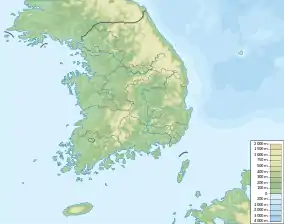Uhangri Formation
The Uhangri Formation, located at the Uhangri Dinosaur Fossil Site, is a geological formation from which fossil pterosaur tracks have been recovered near Haenam-eup, Jeollanam-do, South Korea.[1]
| Uhangri Formation Stratigraphic range: Santonian-Campanian ~85 Ma | |
|---|---|
| Type | Geological formation |
| Unit of | Haenam Group |
| Lithology | |
| Primary | Sandstone |
| Other | Shale |
| Location | |
| Coordinates | 34.6°N 126.4°E |
| Approximate paleocoordinates | 38.5°N 115.0°E |
| Region | Cholla-namdo, Jeollanam-do |
| Country | |
 Uhangri Formation (South Korea) | |
Uhangri Dinosaur Fossil Site
| Uhangri Formation | |
| Hangul | |
|---|---|
| Hanja | |
| Revised Romanization | Uhangni gongnyong hwaseok jayeonsa yujeokji |
| McCune–Reischauer | Uhangni kongnyong hwasŏk chayŏnsa yujŏkchi |
The Uhangri Dinosaur Fossil Site area was originally covered by ocean, uncovered when Lake Damsuho, and surrounding area, was created by the construction of the Geumho Tide project.
Lake Damsuho has cliffs that are 3 to 4 metres (9.8 to 13.1 ft) high, stretching across about 5 kilometres (3.1 mi), made up of sedimentary rock formed during the Cretaceous age. Embedded in the rock formations around the lake are fossilized footprints of dinosaurs, pterosaurs and water birds that lived in this area tens of millions of years ago.
No other place in the world has fossil footprints of all these different dinosaurs found in a single area. The footprints of a pterosaur discovered in this area is the largest in the world at a length of 20 to 35 centimetres (7.9 to 13.8 in).[2]
Vertebrate paleofauna
Pterosaurs
Pterosaur remains from the Uhangri Formation are housed at the Dinosaur Tracks Museum, of the University of Colorado at Denver and Chonnam National University, Gwangju, South Korea.[3]
| Pterosaurs of the Uhangri Formation | ||||
|---|---|---|---|---|
| Taxa | Presence | Description | Images | |
| Haenamichnus[3] | Haenamichnus type locality[3] | |||
| Pteraichnus | Haenamichnus type locality[3] | |||
See also
References
- Uhangri Formation at Fossilworks.org
- "visitkorea". Retrieved 2013-03-19.
- Lockley et al., 2008
Bibliography
- Lockley, M.; Harris, J.D.; and Mitchell, L. 2008. "A global overview of pterosaur ichnology: tracksite distribution in space and time." Zitteliana. B28. p. 187-198. ISSN 1612-4138
- K.-G. Hwang, M. Huh, M. G. Lockley, D. M. Unwin, and J. L. Wright. 2002. New pterosaur tracks (Pteraichnidae) from the Late Cretaceous Uhangri Formation, southwestern Korea. Geological Magazine 139:421-435
- Y.-N. Lee and M. Huh. 2002. Manus-only sauropod tracks in the Uhangri Formation (Upper Cretaceous), Korea and their paleobiological implications. Journal of Paleontology 76(3):558-564
- Y.-N. Lee, K.-M. Yu, and C. B. Wood. 2001. A review of vertebrate faunas from the Gyeongsang Supergroup (Cretaceous) in South Korea. Palaeogeography, Palaeoclimatology, Palaeoecology 165:357-373
- S.-Y. Yang, M.G. Lockley, R. Greben, B.R. Erickson, and S.-K. Lim. 1995. Flamingo and duck-like bird tracks from the Late Cretaceous and Early Tertiary: evidence and implications. Ichnos 4:21-34
